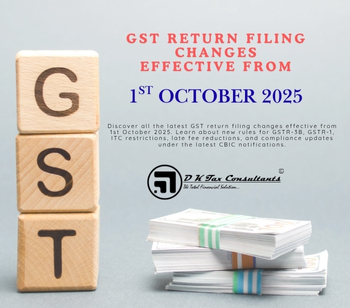GST Return Filing Changes Effective from 1st October 2025: A Complete Guide for Taxpayers
GST Return Filing Changes Effective from 1st October 2025: A Complete Guide for Taxpayers
By D K Tax Consultants | www.dktaxcons.com
Date: October 2025
Introduction: A New Era of GST Compliance
The Goods and Services Tax (GST) system in India is set to undergo one of its most significant overhauls since 2017.
Effective 1st October 2025, the Next-Generation GST Return Filing System will come into force, fundamentally changing how taxpayers file returns, claim Input Tax Credit (ITC), and reconcile invoices.
These reforms, introduced through Notification No. 16/2025 – Central Tax dated 17th September 2025 and approved in the 56th GST Council Meeting, are designed to promote accuracy, transparency, and accountability in GST compliance.
However, they also require taxpayers, accountants, and businesses to adopt more disciplined compliance practices and better coordination with suppliers.
Why These Changes Were Introduced
The Government initiated these changes to resolve long-standing challenges under the existing return filing structure, such as:
- Frequent mismatches between GSTR-1 and GSTR-3B
- Incorrect or fraudulent ITC claims
- Delay in corrections due to multiple return layers
- Weak correlation between supplier and recipient data
The Next-Generation GST Return Filing System, centered around the Invoice Management System (IMS), aims to create a one-to-one traceability between supplier invoices and ITC claims made by recipients.
Key Changes in GST Return Filing from 1st October 2025
1. Introduction of the Invoice Management System (IMS)
- A new Invoice Management System will serve as the central dashboard for managing all inward invoices, debit notes, and credit notes.
- Taxpayers will be required to accept, reject, or mark invoices as pending before claiming ITC.
- Only invoices marked as “accepted” will appear in GSTR-2B and be eligible for ITC in GSTR-3B.
Impact: The automatic ITC system will be discontinued, and manual verification will become mandatory to ensure greater accuracy.
2. Manual Verification of ITC – Discontinuation of Auto-Population
- ITC will no longer be auto-populated in GSTR-3B based on GSTR-2B.
- Each taxpayer must manually verify invoice details and input eligible ITC after confirming them in IMS.
Impact: Businesses will need to enhance reconciliation processes and ensure every invoice is validated before claiming credit.
3. Limited Period for “Pending” Status
- Taxpayers may keep invoices in “Pending” status for review or clarification.
- The “Pending” option will be valid only for one tax period (monthly or quarterly, depending on the filer).
Impact: Failure to act within this period may result in automatic rejection of the invoice and loss of ITC.
4. Invoice-Level ITC Reversal Requirement
- Reversal or reduction of ITC (due to mismatch, rejection, or credit notes) must now be done invoice-wise rather than in a lump sum.
Impact: This change brings more precision and control but increases the compliance workload for accounting teams.
5. Hard-Locking of Outward Supply Data
- Data reported in GSTR-1 or IFF will automatically populate in GSTR-3B, and the values will be non-editable.
- Corrections can only be made through GSTR-1A before filing the return.
Impact: This ensures consistency between GSTR-1 and GSTR-3B, reducing mismatches and errors.
6. Validation of Credit Notes and Debit Notes
- A supplier cannot reduce tax liability through a credit note unless the recipient has reversed or not availed ITC on the corresponding invoice.
- This establishes a two-way verification between supplier and recipient.
Impact: Better synchronization and accountability between both parties, minimizing misuse of credit notes.
7. Three-Year Limitation on Return Filing and Amendments
- No GST return older than three years from its original due date can be filed or amended.
Impact: Taxpayers must ensure that any pending or erroneous filings are corrected before the limitation period expires.
8. Mandatory Review of Invoices in IMS Before Claiming ITC
- Before claiming ITC, taxpayers must mark all relevant invoices as “Accepted” in IMS.
- Only accepted invoices will be eligible for ITC in GSTR-3B.
Impact: This ensures that ITC is claimed only against genuine, verified invoices.
9. Enhanced Audit Trail and Data Matching
- Each ITC entry will now be traceable to an accepted supplier invoice.
- Authorities will have improved data analytics capabilities to detect mismatches and potential fraud.
Impact: Greater transparency and higher scrutiny during audits and departmental verification.
Complementary Structural Reforms
Alongside the return filing reforms, the following systemic changes are being introduced:
- Rate Rationalisation: Simplification of tax slabs by merging 12% and 5% categories.
- Supplier Accountability: ITC eligibility will be directly linked to supplier compliance and filing accuracy.
- Technology-Based Scrutiny: Use of data analytics and AI to identify high-risk transactions and anomalies.
Steps Businesses Should Take to Prepare
To adapt effectively to the new regime, taxpayers should begin preparation well in advance.
1. Upgrade Accounting and ERP Systems
Ensure that your accounting software integrates with the IMS dashboard for real-time invoice reconciliation and acceptance workflows.
2. Conduct a Comprehensive Reconciliation Before October 2025
Resolve discrepancies between GSTR-1, GSTR-2B, and GSTR-3B for previous periods to avoid complications under the new regime.
3. Train Accounting and Compliance Staff
Educate the team on new workflows, such as invoice-level acceptance, rejection, and reversal procedures.
4. Strengthen Supplier Coordination
Establish timelines and communication channels to ensure suppliers upload and correct invoices promptly through GSTR-1A.
5. Maintain Robust Documentation and Audit Trail
Ensure that all invoices, credit notes, and reversals are documented, traceable, and reconciled periodically.
Illustration of Change
Under the Existing System:
- ITC is auto-populated in GSTR-3B based on supplier uploads in GSTR-1.
- If the supplier delays filing, the recipient’s ITC gets deferred.
Under the New System (Post 1st October 2025):
- The recipient must manually accept invoices in IMS.
- Only accepted invoices are reflected in GSTR-2B and eligible for ITC in GSTR-3B.
- Unaccepted or rejected invoices are ineligible for ITC until corrected by the supplier.
Summary of Key Differences
|
Particulars
|
Existing System
|
New System (From 1st October 2025)
|
|
ITC Claim
|
Auto-populated from GSTR-2B
|
Manual acceptance via IMS
|
|
Pending Invoice Review
|
Not time-bound
|
Must act within one tax period
|
|
ITC Reversal
|
Aggregate reversal
|
Invoice-wise reversal
|
|
GSTR-3B Liability
|
Editable
|
Locked from GSTR-1
|
|
Supplier-Recipient Linkage
|
Indirect
|
Mandatory invoice-level verification
|
Conclusion
The GST Return Filing Reforms effective from 1st October 2025 signify a major transformation toward a transparent, accountable, and data-driven tax ecosystem.
While the initial transition may increase the compliance burden, it will ultimately lead to better accuracy, fewer disputes, and improved trust in the tax system.
This content is curated by D K Tax Consultants for general awareness. It is not a legal opinion or professional advice. The views expressed are based on prevailing regulations and interpretations at the time of writing. For personalised assistance, please contact our team at www.dktaxcons.com. Terms and conditions




